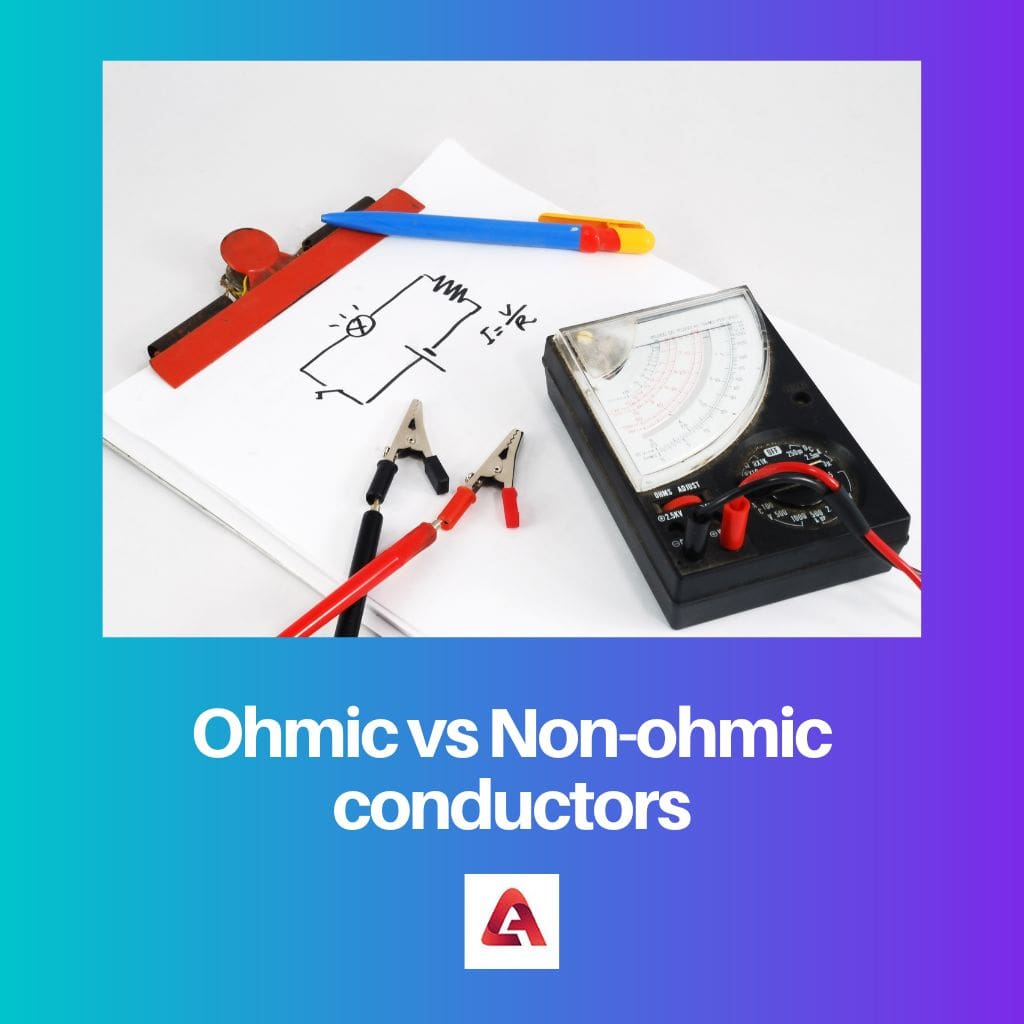An important law to establish the relationship between current, voltage, and resistance was given by Georg Ohm was named Ohm’s law which is given as follows-
V= I * R
V stands for voltage, I for current, and R for resistance.
While designing electrical devices, it is important to remember Ohm’s law that their current and voltage are within specifications.
Conductors are of two types, namely, ohmic conductors and non-ohmic conductors. Ohmic conductors follow Ohm’s law; that is, their resistance remains the same on changing the current and voltage.
Key Takeaways
- Ohmic conductors are materials that follow Ohm’s Law, meaning that the current through the conductor is directly proportional to the voltage applied; non-ohmic conductors do not follow Ohm’s Law and exhibit a non-linear relationship between current and voltage.
- Ohmic conductors have a constant resistance, regardless of the voltage or current, while non-ohmic conductors have resistance values that change depending on the voltage or current.
- Examples of ohmic conductors include metals like copper and silver; non-ohmic conductors can include diodes, thermistors, or filament lamps.
Ohmic vs. Non-Ohmic Conductors
Ohmic conductors obey Ohm’s Law, which states that the current passing through a conductor is directly proportional to the voltage applied, provided that the temperature and other physical parameters remain constant. Non-ohmic conductors do not follow Ohm’s Law and have varying resistance with changing voltage or current.

Comparison Table
| Parameter of Comparison | Ohmic Conductors | Non-Ohmic Conductors |
|---|---|---|
| Basic definition | The ohmic conductors follow Ohm’s law, which implies that the resistance of the conductors remains constant on varying currents and voltages. | The non-ohmic conductors do not follow Ohm’s law, which means the resistance of the conductor varies on sharing current, voltage, and temperature. |
| Relationship between current and voltage | In ohmic conductors, the current and voltage are directly proportional; that is, there is a linear relationship between current and voltage. | In non-ohmic conductors, the current and voltage are not directly proportional; that is, current and voltage have a non-linear relationship. |
| The slope between current and voltage | The slope between current and voltage in ohmic conductors is a straight line. | The slope between the current and the voltage in non-ohmic conductors is not straight but a curved line. |
| Effect on temperature variations | Conductors follow Ohm’s law when the temperature is in the range for which the conductor has been made. Still, as the temperature increases, ohmic conductors behave as non-ohmic conductors. | In non-ohmic conductors, the resistance of the conductors varies according to the variation in the temperature. |
| Examples | Examples of ohmic conductors are metals, resistors, nichrome wires, etc. | Nonohmic conductors include diodes, semiconductors, electrolytes, thyristors, transistors, filament lamps, etc. |
What are Ohmic Conductors?
The ohmic conductors follow Ohm’s law implying that the resistance of the conductor remains constant while varying current and voltage. In other words, it can be said that the relationship between the current and the voltage is linear.
When plotted on a graph, the slope of the current and voltage for ohmic conductors comes out to be a straight line. One of the drawbacks of ohmic conductors is that they lose their properties when operated in ranges other than specified.
Examples of ohmic conductors are metals, resistors, etc. When the current flows through the resistor, it is directly proportional to the voltage, or it can be said that they have a linear relationship.

What are Non-ohmic Conductors?
The non-ohmic conductors are those which do not follow Ohm’s law. Not following Ohm’s law means that their resistance is variable; it varies according to the current, voltage, or temperature change.
Graphically speaking, the slope of the current and voltage for non-ohmic conductors is not a straight line but a curved line. The properties of non-ohmic conductors also vary according to the change in temperature.
In filament lamps, if the voltage is continuously increased, but the currents don’t increase beyond a particular value, it is said to be non-ohmic.

Main Differences Between Ohmic and Non-Ohmic Conductors
- Conductors follow Ohm’s law only in the temperature range for which they are designed; they lose their properties when operated on a higher temperature which is more than the specified range, while in non-ohmic conductors, the resistance of the conductor varies with the varying temperature.
- Examples of ohmic conductors are metals and resistors, while examples of non-ohmic conductors are diodes, transistors, semiconductors, etc.
- https://www.sciencedirect.com/science/article/pii/002230937290227X
- https://www.tandfonline.com/doi/abs/10.1080/14786445008560976

I’m disappointed by the enigmatic conclusion.
This is fascinating. Thank you for sharing this valuable information!
I always thought that Ohm’s law was fairly basic. This is a whole new perspective.
I need to read this over at least two more times before I can fully take in all the information. A really solid read!
This article was very informative and enlightening.
I couldn’t agree more. What an eye-opener.
I believed that Ohm’s law is just that, a law. I had no idea that there were exceptions to it. This is truly intriguing.
I have to reconsider everything I thought I knew about Ohm’s law.
Absolutely, this has made me rethink some of the fundamentals on the topic.
If this is supposed to be funny, I didn’t get the joke.
I’m astounded that this new information has been overlooked for so long.
An exceptional read and a great expansion of my understanding. Good job!
Most definitely, I found this to be captivating.
I’ve never seen Ohm’s law broken down like this before. It’s a substantial advance in my knowledge.
Agreed, I was just discussing Ohm’s law with someone the other day and what you’ve said here has brought new depth to the conversation.
I intellectually disagree with your conclusions.